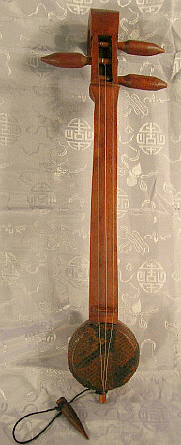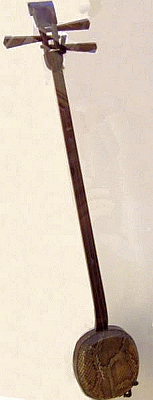 |
||||||||
SanXian |
||||||||
 |
The sanxian (Chinese: 三弦 (絃?), literally "three
strings") is a Chinese lute — a three-stringed fretless plucked musical
instrument. It has a long fingerboard, and the body is traditionally made
from snakeskin stretched over a rounded rectangular resonator. It is made
in several sizes for different purposes and in the late 20th century a
four-stringed version was also developed. The northern sanxian is generally
larger, at about 122 cm in length, while southern versions of the instrument
are usually about 95 cm in length. A large northern Chinese sanxian (大三弦) The sanxian has a dry, somewhat percussive tone and loud volume similar to the banjo. The larger sizes have a range of three octaves. It is primarily used as an accompanying instrument, as well as in ensembles and orchestras of traditional Chinese instruments, though solo pieces and concertos also exist. Its use in ensembles tends to be analogous to the bass part of continuo. The sanxian is used in nanguan and Jiangnan sizhu ensembles, as well as many other folk and classical ensembles. A sanxian Traditionally the instrument is plucked with a thin, hard plectrum made from animal horn but today most players use a plastic plectrum (similar to a guitar pick) or, alternately, their fingernails. This use of fingers to pluck the instrument often shares technique with that of the pipa and is most commonly used in performance of sanxian arrangements of works traditionally written for the pipa. This allows for pipa techniques such as tremolo to be used. Other techniques for sanxian include the use of harmonics and hitting the skin of the instrument with the plectra or fingernail (comparable to the technique used to play the northern Japanese tsugaru-jamisen). A closely related musical instrument is the Japanese shamisen, which is derived from the sanxian but which generally uses cat or dog skin rather than snakeskin to cover its resonator. Even more closely related is the Okinawan sanshin, which is also covered in snakeskin. Additionally, the sanshin and sanxian share a structurally similar body part consisting of a round-edged square of wood. In the Japanese shamisen, the body (sao) is made of four pieces of wood instead of one. The Vietnamese đàn tam is also very similar to the sanxian. In addition to its use in traditional and classical Chinese music, some popular and rock musicians have used the sanxian, most notably the singer He Yong. Although the sanxian has historically been one of the most popular Chinese folk instruments (particularly for accompanying singing), a major decline in the number of sanxian players in classical contexts has been the cause of great concern among enthusiasts of the instrument. As many Chinese orchestras exclude the sanxian, many people are unwilling to learn this instrument. Even in China, very few conservatories offer majors in sanxian, and the small number of students of this instrument, as compared to the guzheng or pipa, for example, have led to further concerns that the instrument's rich playing traditions may be lost forever. One reason for this is the fact that, unlike the shamisen in Japan, the sanxian lacks an original solo repertoire of its own, with most sanxian solo pieces being arrangements of pipa melodies, as in the case of "Big Waves Wash Against the Sands". For the most part, use of the sanxian in the Chinese orchestra is as a provider of a de facto bass line. Also, as the neck of the da sanxian is particularly long, there is a great deal of limitation on how virtuosic a sanxian player can be. This is not an issue in the smaller saxian, which are closer in size to the Japanese shamisen. Like the shamisen, the sanxian is an instrument particularly susceptible to humidity, although the snake skin used in the sanxian is somewhat more durable than the membranes of the shamisen. As such, storing the sanxian in an environment that is less humid can aid in prolonging the life of the snake skin resonator. Many musicians put silica gel in the instrument case to help keep the case from becoming overly humid. Information extracts reproduced from Wikipedia under 'Collective Commons License' http://en.wikipedia.org/wiki/Sanxian Video source: http://www.youtube.com/watch?v=VK_7HxUQSxM |
|||||||
 |
||||||||
|
||||||||